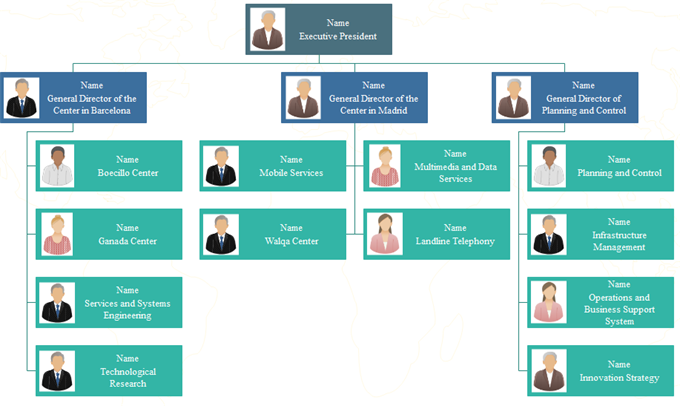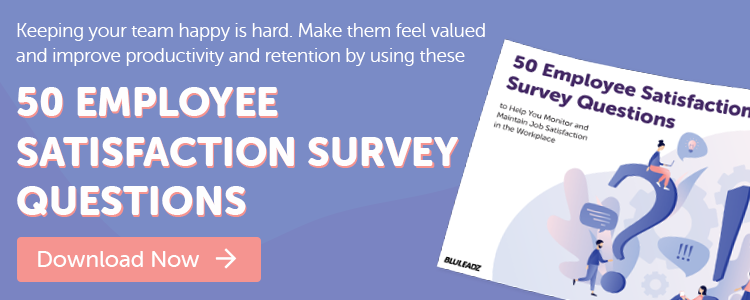Job satisfaction is an important part of building an amazing team.
It might even be the most important part.
That’s especially true now, as the soaring economy has changed the game in today’s job market. There are plenty of opportunities for experienced professionals who want to achieve more – they don’t have to wait for a recruiter to reach out.
If you wake up to find your best talent flew the coop, job satisfaction is probably why.
What Is Job Satisfaction?
Job satisfaction, or employee satisfaction, is just what it sounds like – it’s how happy or satisfied employees are with their jobs. Employee satisfaction can easily affect motivation, goal achievement, and positive morale at work.
Satisfied employees are often more loyal to your company and put in the extra effort to crush company and personal business goals. They can be an ambassador for your brand.
Employee Satisfaction vs. Employee Engagement
While employee satisfaction dictates the extent to which an employee is happy with their job and work environment, employee engagement focuses on the extent to which an employee is passionate about their job and goes the “extra mile” when it comes to their work.
Engaged employees show more motivation at work, don’t back away from a challenge, and can often show leadership skills.
Why Is Job Satisfaction Important?
Employee satisfaction (or lack thereof) influences both employees and organizations. Why?
A dissatisfied employee is less likely to be productive, perform well, and might develop job stress. This, in turn, can result in low morale and less loyalty to the company they work for.
Focusing on job satisfaction throughout your organization is key to the productivity and motivation of your employees – and it can help reduce employee turnover.
6 Key Factors of Job Satisfaction
To better understand ways you can improve job satisfaction at your company, it is first important to understand the factors that affect employee satisfaction.
Some of the biggest factors that contribute to employee satisfaction include:
Compensation
Fair compensation continues to be a large factor in employee happiness and job satisfaction because workers often view their compensation as a reflection of how their employer values the results they deliver for the company.
Respect and Appreciation
Wherever you work, feeling respected and appreciated is a great feeling, and it can impact motivation and work ethic. Research from the Harvard Business Review revealed that employees who feel their superiors treat them with respect are 63 percent more satisfied with their jobs.
Employee-Leadership Relationship
No one wants to feel like their boss doesn't care about them.
Not everyone wants to hit up HR with every issue that comes up, so many employees wish to develop relationships with their direct supervisor so they know they can openly discuss concerns and issues they might be having.
Communication/Transparency
Communication is key at every company. Employees don’t want to feel like they are left out on big company news, and poor communication throughout the organization can lead to confusion, uncertainty, and lower morale.
Work Environment
Poor work environments (too loud, too hot, dirty) can make it difficult for employees to get their work done. Employees want a healthy, safe work environment that feels welcoming and supportive so that they can carry out their daily tasks easier.
Company Culture
According to research by Speakap, 79 percent of American workers say company culture is an important factor in job satisfaction.
When people feel connected to their workplace culture, they become more productive and engaged. They are also more likely to actively seek out advancement and less likely to jump ship when another opportunity arises.
15 Ways to Improve Employee Satisfaction at the Office
1. Listen.
People are more likely to feel invested – in a process, a team, or an organization – when they’ve had a hand in building it. That’s why you should never restrict problem solving to executives. Not all perspectives are equal, but good ideas can come from anyone.
“Big tent” decision making means giving everyone the opportunity to stay informed about your big picture objectives. Then, make it easy for them to weigh in with their thoughts, whether that means an “open door” policy, a suggestion box, or an online feedback system.
The same approach should extend to issues that cause friction and reduce productivity. When teams have avenues to deal with these issues constructively, they do. When they don’t, they vote with their feet. And before you know it, a trickle of departures can become a flood.
2. Provide Clear, Actionable Feedback.
Evaluations can be awesome tools for building strengths and addressing weaknesses.
After all, even people with a lot of self-knowledge have blind spots. An outside opinion might be just what it takes to move forward and break through patterns that are holding you back.
Feedback that boosts job satisfaction is:
- Timely: Feedback should follow the precipitating event as close as possible.
- Frequent: Feedback should happen enough so a pattern of growth can be seen.
- Clear: Feedback should stick to what matters most and avoid drifting off track.
- Actionable: Feedback should focus on what’s in a person’s sphere of influence.
When feasible, organizations will get the most mileage from a “one on one” approach to feedback, with brief weekly or biweekly meetings. This ensures relevant, fresh feedback will be available. It also helps build rapport between team members and their immediate supervisors.
3. Support Skill Development.
Organizations that are willing to help their personnel evolve and improve will win greater loyalty than those who don’t.
No matter what the economy is like, employment decisions aren’t just “dog eat dog” – people remember those who have helped them along the way.
Talent development can be baked into an organization in many ways:
- Put someone in charge of talent development and have internal skill-building groups.
- Provide tuition support for team members who seek relevant degrees or certifications.
- Add tickets and travel for key industry conferences into your human resources budget.
4. Train Leaders to Lead.
It’s been said time and again: People don’t leave companies, they leave managers.
Unfortunately, many managers are initially selected for specialized skills – like sales or coding, for example – and are simply expected to pick up leadership chops along the way.
This “learn as you go” approach might seem organic, but it allows for plenty of mistakes that may not get corrected. With this in mind, it’s crucial that leaders receive training in how to deal with people.
While management focuses on deft application of practical skills, leadership has an emotional dimension that can’t be ignored. Communication, emotional intelligence (EQ), and other soft skills should be integral to leadership training, not an afterthought.
5. Keep Your Values Consistent.
Core values essentially shape your company culture, define your company’s brand, and unite employees.
But, values that contradict your company’s mission or conflict with each other can be confusing and unclear. Therefore, ensure that your company’s core values are clear, concise, and properly represent your business’s goals and work ethic.
6. Keep Employees Informed.
Holding brief meetings on a consistent basis can help keep your employees informed on any company updates, client/customer news, new deals in the pipeline, and any concerns that may have come up.
This can definitely be beneficial for businesses who work in segmented departments or teams, as it allows everyone to get caught up on what's happening across the board.
Encourage every employee to be at these meetings – for those working remote, give them time to dial a coworker or a conference line so they can stay in the loop as well.
7. Give Employees a Place to Unwind.
Everyone needs a break now and again. Burnout is a real thing in the workplace, so anything you can do to reduce or eliminate that will help make your employees happier in their day to day.
Oftentimes, a company break room is the best place for staff to get away from their work for a moment and relax. Plus, it gives them a reason to get up from their desk, which has health benefits of its own.
Gaming areas and quiet zones can also be an excellent place for employees to take a quick break. At Bluleadz, we have a ping pong table in our second office space – let's just say it's our favorite stress reliever and break-time activity!
8. Stop Micromanaging.
When you're in a leadership role, it's obvious you want your team to succeed and for the best possible product/solution to be created.
However, sometimes it's important to take a step back and let the team work it out for themselves. When you hover over them the entire time, it can come off as though you don't trust them or think they aren't skilled enough to accomplish it on their own.
To better manage your employees, work on developing your own project management style and allow your employees to do the same. This, as a result, can improve productivity, collaboration, and quality of work.
9. Increase Employee Engagement.
Getting your employees engaged and involved in the company is one way to help foster loyalty and satisfaction.
Hosting team building events, both in and out of the office, will encourage your staff to engage and interact with one another, which can be especially beneficial for larger businesses who might not get together as an entire organization as frequently.
A few great team building activities you could try include:
- Monthly happy hour
- Scavenger hunt
- Trivia night
- Axe throwing
- Escape room
Employee engagement doesn't have to be created through crazy, out-of-the-box activities, either. One way to encourage engagement in a typical work week is to get the whole staff involved when an issue or challenge arises.
Give your employees the opportunity to contribute new ideas to solve the issue at hand – this brainstorming session can build teamwork and creative thinking and can lend itself to fostering new relationships in the organization.
10. Define Growth Opportunities/Career Paths.
Not many people want to do the same thing forever. And, the feeling of being in a dead-end job can discourage employees from wanting to excel and do better than they already are.
Provide and show clear career advancement opportunities at your company. Where can your employees be in one year, five years, even 10 years if they continue to perform well and deliver impactful results for your business?
This is where an organizational chart can come in handy.

Source: orgcharting.com
An organizational chart is a visual diagram that outlines a company's internal structure and details the roles, day-to-day responsibilities, and relationships between employees.
By sharing your org chart with your employees, they can visualize their next step in the company. They will be able to see what is expected of them and what training is available to help them advance in their career path.
11. Recognize Good Work.
Recognition goes a long way in the workplace. Take a look at the impact employee recognition has on engagement and work relationships:
- 69 percent of employees say they would work harder if they thought their efforts were better appreciated. (Socialcast)
- 50 percent of employees believe receiving thanks from higher-ups improves the relationship and enhances trust with their superiors. (Cicero Group)
- 28 percent of the most memorable and impactful recognition comes from a manager. (Gallup)
Give a reason for employees to celebrate their wins and achievements. Employee milestones, such as work anniversaries, and employee-of-the-month programs can be simple yet impactful ways to recognize excellent work from your team.
At Bluleadz, we have a designated reserved parking spot in our office building parking garage that one team member awards another each month. This employee-to-employee recognition helps unite the company and applaud great teamwork!
12. Loosen Up on the Dress Code.
Surprisingly, dress codes can cause stress for employees.
The tight restriction of what can and can't be worn at the office can force people to buy new clothes and create frustration every morning when picking out what to wear.
By allowing your staff to wear clothes they are happier in (within reason, of course) and ditching the standardized closed-toe shoe and tie policy, employees can be a little more personalized in their outfit choices and dress more comfortably for the work day.
13. Stock the Break Room.
One of the simplest ways to keep your employees happy is to stock your kitchen or break room with delicious goodies to snack on.
Oftentimes, people might not have enough time between meetings and tasks to grab lunch, so providing the opportunity to grab a quick bag of chips and soda on their way to the conference room will keep them – and their stomachs – satisfied.
Try to accommodate everyone at the office and fill the cabinets with a variety of snacks – not everyone enjoys Doritos and Pepsi, so be sure to provide some healthier alternatives for those who prefer it.
14. Create a Positive Work Environment.
The environment and surroundings people work in can affect their happiness and productivity.
This is why it's important to create and build a positive work environment for your employees who are coming in every day to help deliver results for your business.
Hostile or negative work environments will only distract and discourage employees from accomplishing daily tasks. You should keep your employees focused on the positive things to motivate them and increase satisfaction.
To build a workplace that overflows with positivity, consider:
- Encouraging open communication between employees and leadership.
- Highlighting what is going right rather than harping on what's going wrong.
- Telling the truth and not beating around the bush about company issues.
- Lightening up on strict work hours to accommodate people's personal lives and commutes.
15. Focus on the Long Term.
While quick wins and short-term goals have their benefits, they also can create frustration among employees who think their hard work and effort has only a short-term effect on the company's growth.
Keep your company focused on one main, long-term goal to encourage a united front. Consider what your mission statement and vision statement means to your staff, and let that message resonate through your business to motivate and encourage high-value results.
All in all, let your employees know that all the hard work is worth it.
Measuring Employee Satisfaction: Free Survey Template

One of the best ways to measure and track employee satisfaction at your organization is to get feedback directly from your staff.
Sending out a monthly, quarterly, or yearly employee survey can help you identify friction in the workplace and address any issues that employees may be having so you know what to improve on from a leadership perspective.
To help get your started, we made an employee satisfaction survey template for you!
In this template, we cover the top questions that an employee survey should include to help you get a better understanding of employee happiness, complaints, and concerns.
With these tips, you can craft a company culture that makes job satisfaction a priority. High morale translates into true motivation to go above and beyond that money just can’t buy.


Baylor Cherry
Baylor is an inbound specialist for Bluleadz. As a native Floridian, she enjoys soaking up the Florida sun, buying clothes she can’t afford, and dreaming about one day owning a dachshund.